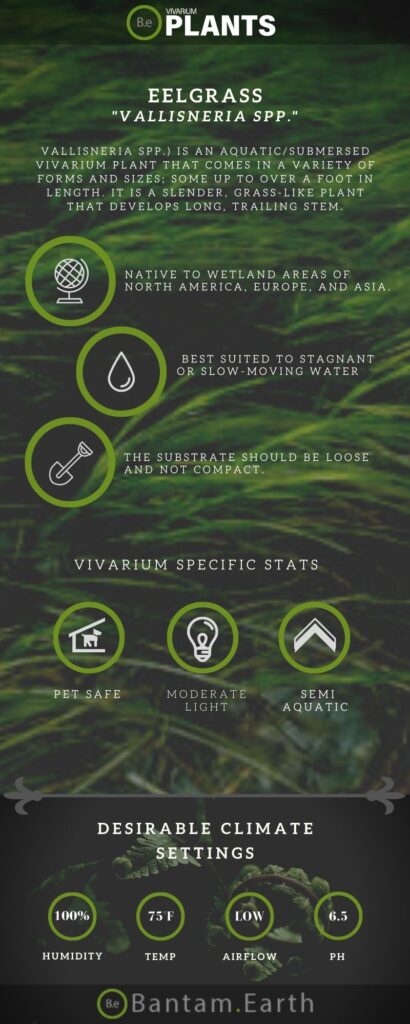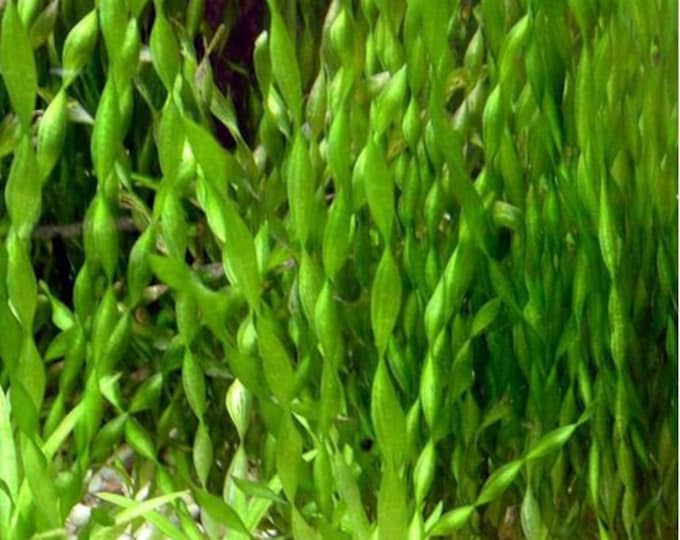If you want a unique and exotic addition to your terrarium, look no further than eelgrass or Vallisneria spp.
This hardy aquatic plant is not only beautiful to look at but can also provide a number of key benefits to your vivarium inhabitants.
In this article, we’ll explore just why eelgrass makes such a perfect addition to the aquarium and why you should consider including it in your next setup.
So read on to learn more and discover why eelgrass is the perfect semi-aquatic plant for you!
| Quick Stats: | |
|---|---|
| Scientific Name | Vallisneria spp. |
| Common Name | Eelgrass, Tape grass |
| Family Name | Bromeliaceae |
| Habitat | Tropical Rainforest, Savanna |
| Temperature | 75°F to 85°F |
| Height | 8 to 24 inches |
| pH | 5.0 to 7.5 |
| Lighting | Moderate |
What is an Eelgrass?
Vallisneria spp. (Eelgrass) is an aquatic/submersed vivarium plant that comes in a variety of forms and sizes; some up to over a foot in length.
It is a slender, grass-like plant that develops long, trailing stems, creating an aesthetically pleasing addition to an aquarium.
It tends to be rugged and sharp to the touch and can be a bit difficult to manipulate if not handled correctly.


Eelgrass Facts
Eelgrass is a hardy plant and is well suited to a variety of vivarium environments.
It can tolerate a wide range of pH levels, from 5.5-7.5, and temperatures from 60-85 degrees Fahrenheit.
This plant is easy to propagate, as the roots can easily be divided and the stems propagated almost effortlessly.
It’s also an excellent source of oxygen for a variety of aquatic and amphibious animals.
Description
Vallisneria spp. has slender, grasslike leaves which grow from short stems.
The leaves range from dark green to light green and can grow as long as 12 inches.
From the root of the plant, wiry runners spread across the substrate surface, growing and creating a carpet-like texture.
These runners are the plants’ primary means of spreading.
Habitat
Eelgrass is a primarily aquatic/submersed plant, native to wetland areas of North America, Europe, and Asia.
It is best suited to stagnant or slow-moving waters with an abundance of organic matter for the roots to attach to.
pH Preference
Vallisneria spp. does best in average pH levels of 6.0-6.5, but can tolerate levels as low as 5.0 and as high as 7.5.
It is important to monitor pH levels to ensure the health of the plant, as too low or too high levels can cause the plant to suffer.
Vivarium Type
Eelgrass is quite an easy-going species. With that in mind, it will not be too complicated when it comes to choosing the type of enclosure it is grown in.
It is best to try and replicate the plant’s natural habitat as much as possible.
Doing so will make it easier to provide this foliage plant with its basic needs.
The proper setup and theme of the enclosure will make a big difference to the overall look and health of the plant.
Be sure to choose setups that are moist and high in humidity.
Here are recommended vivariums it will do well in:
-
- Paludariums – Half aquatic/ half terrain-based enclosure.
-
- Terrariums – Fully terrain-based enclosures with little to no aquatic features.
-
- Ripariums – Mostly aquatic-based enclosures with some terrain features present.
-
- Aquarium– Fully aquatic-based enclosure with little to no dry terrain.
Vivarium Placement
Vallisneria spp. can be propagated and planted in a number of ways, depending on the desired look of the vivarium.
One popular way is to place the plants among hardscape formations such as wood and rocks to give the vivarium edges a more natural appearance.
This plant can also be placed along the edge of aquarium tanks to provide coverage and protection for aquatic inhabitants.
Substrate
The aquatic substrate should be loose and not compact.
Vallisneria spp. will do well in an inert gravel or sand substrate, but can also be grown on soil, coco fiber, or other non-compact substrates.
Be sure to place the stems carefully so that the root system can properly attach and spread along the substrate.
Lighting
Eelgrass prefers medium to low levels of aquatic lighting, preferring to be in indirect light or shade.
Direct sunlight or intense, unfiltered lines can “burn” the leaves, or cause them to become brittle.
Cool or warm white lights work best, as they will bring out the green in the leaves and leaves in your vivarium.
Buy Eelgrass
When it comes to buying Vallisneria spp., there are a few things to keep in mind.
Making sure the plant is healthy when purchased is essential for its success in a vivarium or pond.
Vegetation that is already in poor conditions will have a very hard time adjusting to new environments.
Click the image below to find out more about the current price and other relative info about this plant.
Eelgrass Care and Propagation
Eelgrass is a fairly easy plant to propagate and take care of.
When planted in an appropriate environment, this plant will generally take off, spreading and growing vigorously.
The plant can be propagated easily by separating the stems and replanting them in gravel, sand, loose substrate, or soil.
How to Grow
Eelgrass will generally spread and multiply quickly when placed in an environment with plenty of light and fertilizer.
If the plants are situated in a shady area, growth may be slower.
It is important to ensure that the roots do not become entwined with other plants, as this can stunt the growth of the eelgrass.
Water Requirements
Vallisneria spp. requires tanks with full water.
This plant is best suited to stagnant or slow-moving water, so it is best to leave a little extra water in the tank and only replace it when necessary.
Plants Similar to Eelgrass
Adding diversity to an enclosure is key to an aesthetically pleasing setup.
Try mixing up the look of your vivarium with different flora that can easily co-exist in the same types of environment.
Furthermore, if for some reason you find the Eelgrass hard to acquire or would like to consider something similar to this aquarium plant…
Here are other aquatic plants you might find will do well with or in place of Vallisneria spp.:
Conclusion
Eelgrass (Vallisneria spp.) is an ideal plant for creating a flourishing vivarium environment.
Not only can it provide lots of shelter and food opportunities for tiny creatures living in the tank, but its stunning, versatile aesthetics make it an attractive addition to any setup.
As with any aquatic plant, it needs some regular maintenance but this will be well worth it given the huge benefits to the health and well-being of your aquatic inhabitants.
If you’re looking for a plant for your aquarium, eelgrass should be one of your top considerations!
Frequently Asked Questions
Eelgrass is found in shallow waters in the upper reaches of many estuaries and coastlines in both temperate and tropical regions around the world.
Yes, Vallisneria is easy to grow. It is an aquatic plant that requires little maintenance, and does best in ponds, lakes and aquariums. It does not require special lighting or fertilizer, and can often thrive without any added supplementation.
No, Vallisneria does not need additional CO2 to thrive. Vallisneria is a type of aquatic plant that does not require high levels of carbon dioxide for optimal growth. It is a very hardy plant and able to survive in most aquariums without the need for additional CO2.
Yes, Vallisneria is a great plant for aquariums. It is a hardy plant that requires minimal care, and it helps to create a natural environment for fish by providing oxygen, hiding places, and reducing algae.
No, Vallisneria does not need high light levels to survive. However, without sufficient lighting, Vallisneria will not produce the long, thin leaves and stems that you are likely used to seeing in tanks and ponds. To get the best growth results, Vallisneria should be placed in an area with 3–4 watts of full–spectrum LED light per gallon of water.
Yes, Vallisneria can grow without a substrate. However, they usually prefer a substrate to anchor their roots and receive essential nutrients in order to thrive. Without a substrate, Vallisneria often has difficulty absorbing nutrients, resulting in unhealthy growth.




